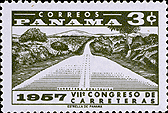| Mapping the Darien The Pan-American Highway |
| Mapping the Darien The Pan-American Highway |
People |
Panama: The Pan-American Highway |
 |
| In the Republic of Panama local
highways have been a subject of "discussions"
between its government and that of the United States
almost since the Isthmian Republic was established in
1903. In the basic convention whereby the right was given
to the United States to construct and operate the
inter-ocean canal, provision; was made for the United
States to hold a monopoly on Trans-Isthmian media of
communications. This restriction, however, did not affect
the construction of roads across the lateral axis of the
country. The eastern third of Panama adjoining Colombia is still in a highly undeveloped state. Virgin jungles, morasses and lands that still invite exploration, especially in the light of being very sparsely populated, offer but little need or inducement for the construction of elaborate roads. Short trails connecting the local villages of Indians have long filled existing needs. In the central and western portions of the country, along the more level lands of the Pacific Coast, the major portion of Panamanian population, commerce and agriculture has been established for many generations. It is not surprising therefore that its best roads are to be found in that part of the country. This stretch covers a distance of approximately 344 miles, from Volcán, near the Costa Rican frontier, to Panama City, and eastward for a distance of about 45 miles. From the Costa Rican border to Panama City, good paved highways offer a comfortable motor road practically throughout the entire year. The construction work on these roads was accomplished almost in its entirety by Panamanian labor. Its financing was provided to the extent of $15,000,000 by the government of Panama and $5,000,000 by that of the United States. The United States' Financing of roads was due largely to the fact that the National Highway would close a substantial gap in the Pan American Highway and would connect various military installations and bases located in the interior of the republic, with the main bases near the canal, particularly the Rio Hato Air Field, 80 miles west of Panama City. The portions of the road constructed with United States funds became the property of Panama with an obligation on the part of that government to keep them in good repair. At the fifth International Conference of American States, held at Santiago, Chile in 1923, the groundwork for the Pan American Highway commission was laid. Since that time several conferences of the delegates of the various governments have been held at which detailed plans were considered for the construction of a unified highway which will ultimately link the twenty- one republics through a single modern motor road. The National Highway of Panama, when finished, will constitute one link in the Great Pan American Highway tying into a closer and more intimate bond the Republics of the Western Hemisphere. |
||
[
Panama ]
[ Impacto, Influencia, Cambio ]
[ History of Science, Technology
and Invention ]